Le premier ministre François Legault implore les Québécois d’être « patients » et « solidaires » dans les prochains jours, afin de passer à travers l’épisode majeur de pannes d’électricité. Son gouvernement envisage « d’autres façons de se protéger » contre d’autres futurs évènements similaires, mais trouve irréaliste d’enfouir tous les fils.
« Je veux dire aux Québécois : soyez patients. Ce n’est pas du tout comme la crise du verglas en 1998, d’abord parce qu’on est en avril et pas en janvier. On ne prévoit pas avoir trois ou quatre jours de verglas », a expliqué M. Legault lors d’une conférence de presse tenue au quartier général d’Hydro-Québec, jeudi.
Il appelle aussi la population à être « solidaires ». « Si vous connaissez des gens seuls, appelez-les et vérifiez s’ils ont besoin d’un endroit où rester », a-t-il notamment illustré, en se disant par ailleurs « surpris » de la vitesse à laquelle le verglas est arrivé.
À l’instar d’Hydro-Québec, le chef du gouvernement a réitéré les appels à la prudence, implorant les citoyens de s’éloigner des fils électriques, et de déplacer les véhicules se trouvant à proximité si possible. Un mot d’ordre a été donné à la Sûreté du Québec et aux municipalités « de ne pas donner de contraventions ».

PHOTO GRAHAM HUGHES, LA PRESSE CANADIENNE
À ce stade-ci, le premier ministre n’envisage pas « pour l’instant » de demander l’aide de l’armée dans le Grand Montréal. « Étant donné que c’est concentré dans la métropole, on est capables de demander à d’autres régions de venir nous aider. »
C’est terrible de voir autant de gens sans électricité. […] The temperature is improving and we hope that we will have a nice Easter holiday for the majority of Quebecers.
Francois Legault, Prime Minister
Unrealistic to bury everything
Earlier, alongside Mayor Valérie Plante, Canadian Prime Minister Justin Trudeau hinted that financial programs exist for provinces wishing to bury their electricity wires, a solution demanded by several citizens at each such event.
But François Legault tempers expectations. “Burying all the wires of Hydro-Quebec, we’re talking about 100 billion. Maybe it’s done in some places, but you have to be realistic,” he said, adding, however, that “that doesn’t mean there aren’t other ways to protect yourself.” . His government, he says, is also “in the process of adding capacity” of production and staff at Hydro-Quebec.
To increase resilience across the province, Legault says work is underway to equip smaller municipalities with “checkpoints, so people can go and shower” during such storms.
A little earlier, during another press briefing held at the same place, the outgoing CEO of Hydro-Quebec, Sophie Brochu, had hammered earlier that he was pressing to start a “societal discussion” in Quebec on the development of longer-term energy “resilience”, repeating that this type of weather event “is likely to happen again more and more”.
At this point, the Prime Minister does not “for the moment” plan to ask for help from the army in Greater Montreal. “Since it is concentrated in the metropolis, we are able to ask other regions to come and help us. »
According to Hydro-Quebec, between 70% and 80% of customers who are in the dark should find electricity by the end of Friday evening, around midnight.
“We are deploying all we can in financial, human and technical resources to connect you as quickly as possible. […] It’s not because it’s hot that we’re going slower, and it’s not because it’s Easter that we won’t give our 100% “, had assured the outgoing CEO of ‘Hydro-Quebec, Sophie Brochu.
Remember that for the time being, the regions most affected by the million outages remain the Outaouais, where the ice storm arrived first, but especially the Montérégie and Montreal. The Quebec metropolitan area accounts for approximately 50% of outages at the present time. Priority is given to citizens in danger, then to health facilities and emergency communication equipment.
